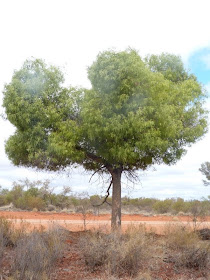I have to specify that in the title, because elsewhere in the world people are likely to think of the superb Murchison Falls in Uganda - and they too will get a turn here in due course. I am prompted by my mention in the last posting of Augustus Gregory's mapping of part the Murchison River in 1848. Both features were named for Sir Roderick Murchison, Scottish geologist and president of the British Royal Geographical Society.
The Murchison River is the second longest in Western Australia, flowing for some 800km from the dry inland Robinson Range to the sea at Kalbarri National Park near Geraldton on the semi-arid Indian Ocean coast, much of the water coming from overflow of salt lakes which fill only during cyclonic summer rains.
 |
| The red arrow point indicates Kalbarri and the mouth of the Murchison, flowing from the north-east. |
The Murchison Gorge in Kalbarri NP is just magnificent, 80 kilometres of huge red sandstone cliffs above the sharply twisting river bed, with wildflower-rich sandy dry eucalypt woodlands on the plains above.
 |
| The Murchison, in the dry season, beneath the cliffs at Ross Graham Lookout, Kalbarri NP. |
 |
| Dry woodlands, typical of the sandplains of Kalbarri above the Murchison. |
 |
| "Nature's Window", a wind-eroded feature high above the Murchison. |
 | ||
| Down at river level, a quiet pool. While the level is low here, after a dry summer when the cyclones don't bring rain this far south, the flow can stop altogether. |
Mind you, it can still rain there even in the dry season!
 |
| Semi-arid Kalbarri NP woodland rapidly becoming awash! |
The rocks contain some fascinating stories too.
 |
| The tubes are in fact Skolithos - casts of the burrows of worms that lived in a shallow sea here some 410 years ago. |
Another fossil here, almost overlooking the Murchison, is one of the most exciting fossil traces I've ever seen. It marks one of the first forays ashore of a major predator, over 400 million years ago in the Silurian.
Today the predators are generally out of sight, but the wildflowers of the Murchison plains are some of the most spectacular in Australia; let me share a few of my favourites with you.
 |
| Tall Mulla Mulla Ptilotus macrocephalus, in almost unimaginably massed flowering; this species is widespread across the arid inland, but I've never seen it like this. |
+Kalbarri+0808.jpg) |
| Pink Milkmaids Burchardia rosea, family Colchicaceae. One of just five species in the genus, this beautiful lily is restricted to the Murchison area. For more about the somewhat mysterious person it was named for, see here. |
Two superb big grevilleas light up the plains too, and are not found much further afield from here.
 |
| Grevillea candelabroides, above, and Grevillea petrophiloides (Pink Pokers) below |
 |
| Wiry Honeymyrtle Melaleuca nematophylla, another magnificent massed display. |
 |
| Verticordia monodelpha, guaranteed to turn both hearts and heads! |
Which indeed is true of the mighty Murchison itself, and the rest of Kalbarri where it ends its journey. Make a date to get there some time, preferably in late winter or early spring.
I am about to head west myself, though not this far north this time, taking a group of people to explore the rich south-west corner. There'll be lots to talk about when I get back, so please don't forget me!
BACK ON TUESDAY 1 OCTOBER




+Gregory+NP.jpg)

















+TdPNP+1107.jpg)









+Kalbarri+0808.jpg)












